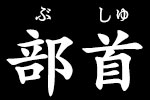🧩 Where the Story of Radicals Begins

In the world of kanji, 部首 or a radical is a key building block — a visual and semantic anchor that plays a major role in both the structure and classification of kanji.
If you look closely at the word 部首, and if you know the meaning of each kanji, you can almost guess what the whole word means.
- Section Head -
The word 部首 literally means “section head.” In practice, this refers to the radical — the part of a kanji used for classification by meaning. Radicals group kanji into sections based on their shared core idea, making the writing system easier to organize and learn.
 The first character 部 means “part” or “section.”
It is built from three parts: 立 (to stand) and 口 (mouth) on the left,
and ⻏ (village) on the right - which serves as the radical(おおざと)here. By tapping the radical image, you can see the details.
The first character 部 means “part” or “section.”
It is built from three parts: 立 (to stand) and 口 (mouth) on the left,
and ⻏ (village) on the right - which serves as the radical(おおざと)here. By tapping the radical image, you can see the details.
Interestingly, while 立 and 口 often act as radicals in other kanji, in this case they do not. Here, 立 and 口 play a different role. Together, this combination often functions as a phonetic element, suggesting pronunciation. This reminds us that kanji components are not only about meaning — they can also give us clues about sound.
The second character 首 means “neck” or “head,” and it is also recognized as a radical in its own right. At first glance it looks simple, but it can be broken down further: the top part resembles まえがしら, a shape also seen in kanji like 前, while the bottom part is the kanji 自.
This shows how even small components — like まえがしら — though not official radicals, still play an important role in shaping kanji. In fact, radicals themselves are sometimes broken down further into smaller components, showing how kanji structure works at multiple levels.
All these components put together, 部首 literally means “section head” — the head of a part. It captures the essence of a radical: the key element under which each kanji is classified.